This section displays herbicide injury symptoms based on the mode of
action of the herbicide, e.g. 2,4-D is in the Growth Regulator
family.
Select the "Classified by Herbicide Active Ingredient" link
to view the section on herbicide injury symptoms based on the common name
(active ingredient) of the herbicide. Most herbicide products will list
the common name under the active ingredient section of the label. A cross
reference list of trade names and common names can also be found in Weed Control
Guidelines for Indiana WS-16.
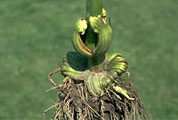 |
CORN
Mode: Growth Regulator
Herbicide: 2,4-D or Dicamba
Injury: Fused Brace Root
Condition: Late application of herbicide where most of corn leaves
and whorl intercept the herbicide; misapplication |
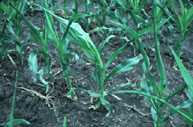 |
CORN
Mode: Growth Regulator
Herbicide: 2,4-D or Dicamba
Injury: Rolled "buggy-whip" Whorl
Condition: Late application of herbicide where most of corn leaves
and whorl intercept the herbicide; misapplication |
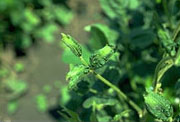 |
SOYBEAN
Mode: Growth Regulator
Herbicide: 2,4-D
Injury: Leaf Strapping
Condition: 2,4-D drift from nearby field, roadside or other area
where herbicide was applied; spray tank contamination |
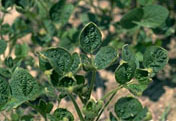 |
SOYBEAN
Mode: Growth Regulator
Herbicide: Dicamba
Injury: Leaf Cupping
Condition: Dicamba drift from nearby field, roadside or other area
where herbicide was applied; spray tank contamination |
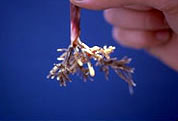 |
CORN
Mode: Seedling Growth Inhibitor
Herbicide: Ethalfluralin, Pendimethalin, Trifluralin
Injury: Clubbed or Swollen Root Tips
Condition: Carryover of herbicide due mostly to lack of moisture
for breakdown or misapplication; stressed conditions (compaction) |
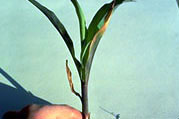 |
CORN
Mode: Seedling Growth Inhibitor
Herbicide: Ethalfluralin, Pendimethalin, Trifluralin
Injury: Discolored shoot as a result of root injury
Condition: Carryover of herbicide due mostly to lack of moisture
for breakdown or misapplication; stressed conditions (compaction) |
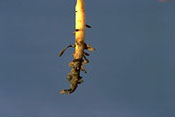 |
SOYBEAN
Mode: Seedling Growth Inhibitor
Herbicide: Ethalfluralin, Pendimethalin, Trifluralin
Injury: Clubbed or swollen root tips; swollen hypocotyl
Condition: Overapplication of herbicide; stressed conditions (compaction) |
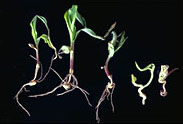 |
CORN
Mode: Seedling Growth Inhibitor
Herbicide: Alachlor, Metolachlor, Acetochlor, Dimethenamid
Injury: Corn Leafing-out underground, improper leaf unfurling
Condition: Misapplication - herbicide rate too high for soil type;
stressed conditions (cool, wet soils) where corn is slowly growing |
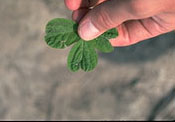 |
SOYBEAN
Mode: Seedling Growth Inhibitor
Herbicide: Alachlor, Metolachlor, Acetochlor, Dimethenamid
Injury: Leaf Malformation
Condition: Overapplication of herbicide |
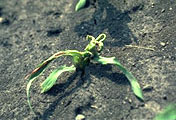 |
CORN
Mode: Seedling Growth Inhibitor
Herbicide: EPTC, Butylate
Injury: Improper leaf unfurling, twisted whorls
Condition: Misapplication; heavy rains soon after herbicide application
that may leach away the herbicide safener; stressed conditions (cool, wet
soils), certain hybrids may be sensitive |